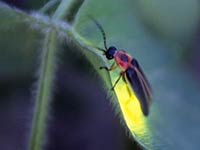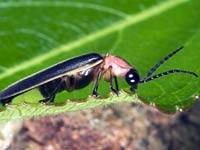-
Firefly

Firefly information and facts:
Type: Bug
Diet: Omnivore
Average lifespan in the wild: About 2 months
Size: Up to 1 in (2.5 cm)
-

Also called lightning bugs, fireflies are neither bugs nor flies: They are beetles. Fireflies use their light-producing organs to flash each other coded messages, all in the interest of finding a mate. The male signals as he flies; the female answers from her hiding place. Each species flashes its own special pattern.
-
Firefly video.

What does a Lightning Bug look like?
Have you ever been in a field at night and sometimes seen little flying specks of light around? Well, if you were to look at one up close you'd realize that these lights are really bugs! These bugs are called fireflies. When you look close-up, you can see that fireflies have soft bodies, compound eyes and a bright, glowing rear end. The firefly's larvae look almost exactly like fully grown fireflies, except that they don't have the compound eyes the adults have.
Where do Lightning Bugs live?
There are about 2,000 firefly species. These insects live in a variety of warm environments, as well as in more temperate regions, and are a familiar sight on summer evenings. Fireflies love moisture and often live in humid regions of Asia and the Americas. In drier areas, they are found around wet or damp areas that retain moisture.
What does a Lightning Bug eat?
Fireflies are predatory when young, but as adults they usually eat honey and nectar. This mixed diet depends on the type of species of firefly as there are around 2,000 different firefly species! The larvae of the firefly mainly eat the larvae of snails and slugs. They catch their prey usually by spitting digestive fluids (like spit and stomach acid) at their prey using organs near their mouth known as mandibles.How do fireflies get their glow?
Everyone knows how fireflies got their name, but many people don't know how the insects produce their signature glow. Fireflies have dedicated light organs that are located under their abdomens. The insects take in oxygen and, inside special cells, combine it with a substance called luciferin to produce light with almost no heat.
Why do the lights of the Firefly blink?
Firefly light is usually intermittent, and flashes in patterns that are unique to each species. Each blinking pattern is an optical signal that helps fireflies find potential mates. Scientists are not sure how the insects regulate this process to turn their lights on and off. Firefly light may also serve as a defense mechanism that flashes a clear warning of the insect's unappetizing taste. The fact that even larvae are luminescent lends support to this theory.What stages of metamorphosis does the firefly go through?
The firefly goes through the four-stage type of metamorphosis known as holometabolism. The firefly starts life as an egg and in three to four weeks hatch into larvae. The larvae hatch mainly in the spring and already glow like the adult firefly. For this reason, the larvae of some firefly species are known as glowworms. Most of the time, the firefly larvae will stay in this stage until the next spring. Then they go into the pupal stage for approximately two weeks. Finally, they emerge as adult fireflies; however, some firefly larvae won't reach the pupal and adult stage for a few years, depending on the species.Firefly images





-

-
Firefly Wallpapers
Download free Firefly wallpapers, click on the image to open the large version. 
Firefly wallpaper 1
Firefly wallpaper 2
Firefly wallpaper 3
Firefly wallpaper 4
Firefly wallpaper 5
-
Firefly Coloring pages
Print free Firefly coloring pages, click on the image to open the large version. 
Firefly coloring page 1
Firefly coloring page 2
Firefly coloring page 3
Firefly coloring page 4
Firefly coloring page 5




